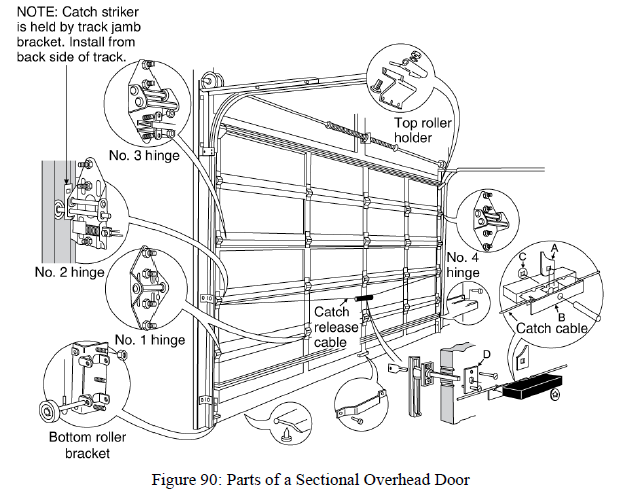Chapter E3 – Installs Specialty Exterior Doors
Key Competencies (NOA)
- Select and use tools and equipment such as levels, chisels, hole saws, screwdrivers, cordless drills, drill bits and routers with templates
- Identify type of specialty exterior doors such as overhead doors, access hatch and bypass doors to determine scope of task
- Assess and adjust rough openings for existing conditions such as out-of-square, out-of-level and wrong size or location
- Secure door components using fasteners such as screws, bolts and anchors, according to manufacturers’ specifications
- Install weather protection devices such as weather stripping and door sweep according to manufacturers’ specifications and site requirements
- Verify proper operation such as latching, spacing and alignment
- Coordinate with other trades to ensure considerations are made for components such as exterior finishes, flooring and access hardware (NOA p. 56-57)
Overhead Doors
Overhead doors are commonly used for garages, storage rooms and service areas.
Types of overhead doors include:
- Slab – one piece door in a metal frame which uses springs and counterbalance to open and close
- Sectional – multiple panels hinged together that slide with rollers on a track
- Rolling Shutter – door made of interlocking horizontal slats that roll up above the door when opened

Review Brightspace Instruction Sheet:
- DOOR 300 – IS 4.1 Overhead Doors, p. 162 – 171
Review Questions
- What are the three main types of overhead doors?
- What is the main disadvantage of a slab door?
- What are three ways an overhead sectional door is designed so as to protect the interior from the weather?
Asnwers:
- Slab doors, sectional doors, and rolling shutter doors.
- It requires extra clearance on the exterior and if the door is left partially open, it projects out on the outside and uses up some space on the inside.
- Sections are ship-lapped or rabbeted to provide a sealed joint, weather stripping is installed around the door on the outside and usually in between the sections, and the sections are insulated in between the metal skin with rigid insulation
